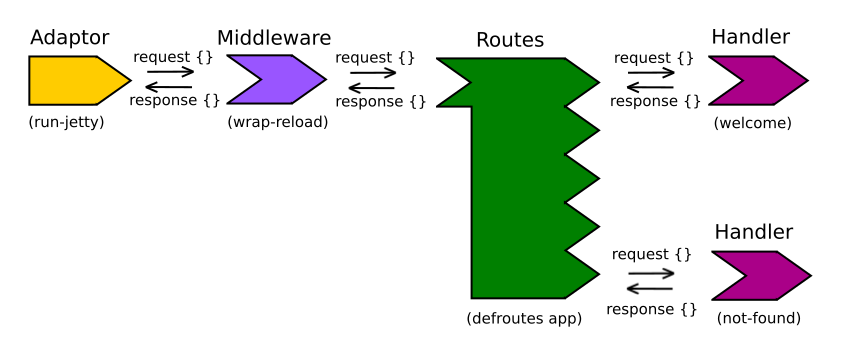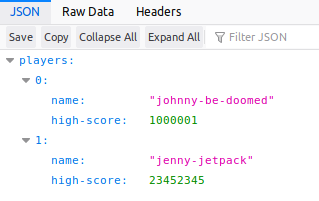Clojure Webapp routing and APIs with JSON

Defining routes for a Clojure webapps is easy with the Compojure library and we can also serve JSON to create a simple API. All this is built on the Clojure webserver we built in the previous article.
Compojure has a defroutes macro that provides a simple way to define routes and there are other convienience functions that make routing very straight forward.
We can also add transit and other libraries to help manage JSON.
All the code for this project is at practicalli/simple-api repository on GitHub.
Understanding compojure
Compojure is a library to define a collection of routes and associate each route with a handler.
- A route is made from an http method and a specific web address or resource address, such as
hello.htmlorresults.json - http method switching - running different code based on the HTTP method (
GET,POST,PUT,DELETE) - A handler is simply a function that takes a request map as an argument by default.
Compojure also has convienience functions that make ring responses easier to generate, eg. response, not-found.

Practicalli Clojure Webapps contains more exmples of compojure.
Adding compojure to deps.edn
Take the simple-api-server project from last time
To find latest version we can look up compojure on clojars.org.
{:paths ["resources" "src"]
:deps
{org.clojure/clojure {:mvn/version "1.10.1"}
http-kit {:mvn/version "2.4.0-alpha4"}
compojure {:mvn/version "1.6.1"}}
:aliases
{,,,}}
Namespace require
To use functions from the Compojure library we include them in the namespace declaration.
The :require directive allows us to specify namespaces who's functions are then available.
compojure.coreprovides the defroutes macro, so we can define routes easily. It also provides the GET and POST macros to match the different types of requests.compojure.routeprovides thenot-foundfunction that returns a standard 404 error. This function would be replaced by a website template with hiccup or selma before going live with the webapp.
Edit src/practicalli.simple-api-server.clj and add the two namespaces.
(ns practicalli.simple-api-server
(:gen-class)
(:require [org.httpkit.server :as server]
[compojure.core :refer [defroutes GET POST]]
[compojure.route :refer [not-found]]))
Tweaking the -main function
Update the run-server function call to use the webapp created with defroutes
(defn -main
"Start a httpkit server with a specific port
#' enables hot-reload of the handler function and anything that code calls"
[& {:keys [ip port]
:or {ip "0.0.0.0"
port 8000}}]
(println "INFO: Starting httpkit server - listening on: " (str "http://" ip ":" port))
(reset! server (server/run-server #'webapp {:port port})))
Starting and stopping the server
Specify a specific port when starting the server
(-main :port 8888)
;; => "Port: 8888, timeout 100"
Or simply start the server on the default port using (-main)
Stopping the server is easy, just call the stop-server functions without arguments.
(stop-server)
It is necessary to stop and start the server when adding dependencies or chaining the main function definition.
Changes made to the webapp function or anything that function calls can be evaluated to update the REPL, so it is not necessary to stop and starting the web server.
Adding Routes with Compojure
defroutes function is a macro to provide a simple way to define all the routes. There is only one defroutes function per web application and all requests received by the server go through this function.
A series of nested
iffunctions or thecondfunction could be used to define routes, although this is not very efficient code.
Each route in defroutes consists of:
- an http method
- URL/URI address
- request map (which can be destructured)
- a handler (or just some content for the body)
Here is a GET request for the main website page. This would be the same as a browser requesting the website page.
A simple piece of html code is used as the response. This html code is associated with the :body of re response hash-map.
(defroutes webapp
(GET "/" [] "<h1>Hello World</h1>"))
The resulting response hash-map would look as follows
{:headers {}
:status 200
:body "<h1>Hello World</h1>"}
Convenience handlers
The response function provides a successful response (status 200) that includes the message passed as an argument.
In deps.edn add the ring.util.response namespace, to give access to the response function.
[ring.util.response :refer [response]]
We can use the response function as part of the defroutes.
(defroutes app
(GET "/" [] (response "Hello clojure world"))
,,,)
Or we can include the response call in a separate handler. A separate handler is more appropriate when there is a notable amount of content included in the message. For example, if you are using a template for the return message.
The message forms the value of the :body keyword in the response map, so its quite flexible as to what can be bound to that :body key.
(defn hello-world
"A simple hello world handler,
using ring.util.response"
[request]
(response "hello clojure world, from ring response."))
In the REPL we can call this function to see what its returning
(hello-world {})
;; => {:status 200, :headers {}, :body "Hello Clojure World, from ring response."}
If no route matches the incoming request, then the browser will display its own error page.
Using the not-found function from compojure.route a custom error message can be returned instead.
(defroutes webapp
(route/not-found "<h1>I am very sorry, but the page you asked for does not exist.</h1>")
)
Using handlers rather than just returning text
(defroutes webapp
(GET "/" [] hello-html)
(GET "/hello-response" [] hello-world)
(not-found "<h1>Page not found, I am very sorry.</h1>"))
(defn hello-world
"A simple hello world handler,
using ring.util.response"
[_]
(response "Hello Clojure World, from ring response."))
Calling the hello-world function with an empty request hash-map, {} we can see the response hash-map this handler function returns
(hello-world {})
;; => {:status 200, :headers {}, :body "Hello Clojure World, from ring response."}
Viewing the full Request information
Compojure has a request dump function that gives a much nicer output than our initial request-info function. The dump function also separates the default response keys with any additional keys provided by the URL.
(:require
[ring.handler.dump :refer [handle-dump]])
Add a route that calls the handle-dump functions
(GET "/request-info" [] handle-dump)
Generating JSON from Clojure
clojure/data.json is a library for translating between Clojure data structures and the JavaScript Object Notation JSON
Clojure hash-maps and vectors can be used to create a detailed data structure that can be converted into JSON.
Add the data.json library as a dependency in the deps.edn file.
org.clojure/data.json {:mvn/version "0.2.7"}
Then require clojure.data.json namespace in the ns declaration.
(ns example
(:require [clojure.data.json :as json]))
To convert to/from JSON strings, use json/write-str and json/read-str functions.
(json/write-str {:a 1 :b 2})
;;=> "{\"a\":1,\"b\":2}"
(json/read-str "{\"a\":1,\"b\":2}")
;;=> {"a" 1, "b" 2}
Converting Clojure data into JSON is lossy as you loose some of the type information.
Other approaches include
- ring-json for handling JSON requests and responses
- ring-json-response for returning JSON responses from a ring handler
Creating a JSON API
Returning JSON from APIs is a common approach as JSON is a very lightweight data format that is supported by many languages. So JSON is usually very simple when it comes to data integration.
Add a scores routes that returns JSON, specifying the appropriate content type.
(defn scores
"Returns the current scoreboard as JSON"
[_]
(println "Calling the scoreboard handler...")
{:headers {"Content-type" "application/json"}
:status (:OK http-status-codes)
:body (json/write-str {:players
[{:name "johnny-be-doomed" :high-score 1000001}
{:name "jenny-jetpack" :high-score 23452345}]})})
This will return JSON in our browser

Defining a data model
Assuming we use the data in several handler functions, we should define that data separately and refer to it by name.
(def scoreboard
{:players
[{:name "johnny-be-doomed" :high-score 1000001}
{:name "jenny-jetpack" :high-score 23452345}
{:name "fred" :high-score 23452345}]})
Specific player score with URL parameters
To get the score for just a single player, use variable path elements as part of the request address.
To get a specific players name, add the :name element.
(defroutes webapp
(GET "/hello/:name" [] player-score)
)
Define a player-score handler function
Define a player-score handler function that only returns the score for a particular player.
To get the name of the player from the request hash-map, we can use get-in to walk the request hash-map. The player name will be in {:route-params {:name "player-name"}}
(get-in request [:route-params :name])
To get the score for a particular player, we filter the scoreboard data structure by the name of the player. For example, if we wanted the score for the player "fred":
(filter (fn [player-entry]
(= "fred" (:name player-entry)))
(get scoreboard :players))
We can use these expressions to build our player-score handler.
(defn player-score
"Returns the current scoreboard as JSON"
[request]
(println "Calling the player handler...")
(let [player (get-in request [:route-params :name])]
{:headers {"Content-type" "application/json"}
:status (:OK http-status-codes)
:body (json/write-str
(filter (fn [player-entry]
(= player (:name player-entry)))
(get scoreboard :players)))}))
Now we can call our scoreboard api with a specific player name, for example http://localhost:8000/player/:jenny-jetpack and just their scores are returned.
If there are going to be multiple scores, then we could sort them first using sort-by :high-score dec on the results of filter to give a list of score entries with the highest score first.
Or we could leave it to the client to process the scores in what ever way they wish.
Summary
Taking the simple web server and adding Compojure allows us to quickly build a web application or API.
Generating JSON from Clojure data structures is very easy. Converting JSON into Clojure data structures is just as easy and provides a more efficient way of working with any data received in JSON format.
There are several libraries for transforming between JSON and Clojure, including Cheshire, jsonista and Transit.
Adding specifications is a clean way to ensure a robust API service, checking the type of information being sent and received is of the correct form. clojure.alpha.spec and pulmatic/schema are two libraries that will provide this kind of checking.
Sean Corfield has a usermanager project that is a nice example of a project using deps.edn, ring, compojure, selma for web page templates and Component for life-cycle management (starting and stoping services).